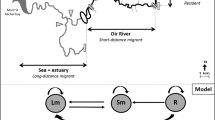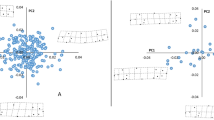Abstract
Competition during the juvenile phase is a key process for regulating density in organisms with high fecundity. Juvenile density-dependent bottlenecks may become even more pronounced if several cohorts compete, but this has received relatively limited attention in previous literature. We performed a manipulation experiment in seven coastal streams to investigate the presence of inter-cohort competition, using habitat selection, body-size and density of newly emerged (age-0) brown trout (Salmo trutta) as response variables. The trout population (age ≥1 fish) was estimated using electro-fishing prior to the emergence of fry (April–May) and was either removed (manipulated sections) or maintained (control sections). Age-0 habitat selection was examined in June while density and body-size was evaluated in October (end of the growth season). We found that age-0 trout selected habitats that were located further from riffles (nursery habitats) in the absence of age ≥1 trout, suggesting a niche overlap between cohorts in the habitat dimension and, hence, that both inter-cohort competitive interactions and ontogenetic preference may influence habitat utilisation in the wild. Furthermore, we also found age-0 body-size to be significantly larger in manipulated sections and negatively related to its own density. We argue that competition from older cohorts influence the availability of age-0 feeding territories at the critical phase of emergence with secondary negative effects on age-0 growth. These results not only have implications for understanding the mechanisms of density dependence but can also provide valuable knowledge to the management of salmonid populations and their habitats in the wild.


Similar content being viewed by others
References
Armstrong JD, Nislow K (2006) Critical habitat during the transition from maternal provisioning in freshwater fish, with emphasis on Atlantic salmon (Salmo salar) and brown trout (Salmo trutta). J Zool 269:403–413
Armstrong JD, Kemp PS, Kennedy GJA, Ladle M, Milner NJ (2003) Habitat requirements of Atlantic salmon and brown trout in rivers and streams. Fish Res 62:143–170
Bakker TCM, Sevenster P (1983) Determinants of dominance in male sticklebacks (Gasterosteus aculeatus L.). Behaviour 86:55–71
Begon M, Harper JL, Townsend CR (1996) Ecology: individuals, populations and communities. Blackwell, Oxford
Bohlin T (1977) Habitat selection and intercohort competition of juvenile sea-trout Salmo trutta. Oikos 29:112–117
Bohlin T, Hamrin S, Heggberget TG, Rasmussen G, Saltveit SJ (1989) Electrofishing: theory and practice with special emphasis on salmonids. Hydrobiologia 173:9–43
Bohlin T, Dellefors C, Faremo U (1996) Date of smolt migration depends on body-size but not age in wild sea-run brown trout. J Fish Biol 49:157–164
Bohlin T, Sundström LF, Johnsson JI, Höjesjö J, Pettersson J (2002) Density-dependent growth in brown trout: effects of introducing wild and hatchery fish. J Anim Ecol 71:683–692
Bremset G, Berg OK (1999) Three-dimensional microhabitat use by young pool-dwelling Atlantic salmon and brown trout. Anim Behav 58:1047–1059
Brotons L, Orell M, Lahti K, Koivula K (2000) Age-related microhabitat segregation in willow tit Parus montanus winter flocks. Ethology 106:993–1005
Claessen D, de Roos AM, Persson L (2000) Dwarfs and giants: cannibalism and competition in size-structured populations. Am Nat 155:219–237
Clark DB, Gibbons JW (1969) Dietary shifts in the turtle Pseudemys scripta (Schoepff) from youth to maturity. Copeia 4:704–706
Copp GH, Peňáz M (1988) Ecology of fish spawning and nursery zones in the flood plain, using a new sampling approach. Hydrobiologia 169:209–224
Crowley PH, Dillon PM, Johnson DM, Watson CN (1987) Intraspecific interference among larvae in a semivoltine dragonfly population. Oecologia 71:447–456
Dellefors C, Faremo U (1988) Early sexual-maturation in males of wild sea trout, Salmo trutta L, inhibits smoltification. J Fish Biol 33:741–749
Edeline E, Haugen TO, Weltzien FA, Claessen D, Winfield IJ, Stenseth NC, Vollestad LA (2009) Body downsizing caused by non-consumptive social stress severely depresses population growth rate. Proc R Soc Lond B 277:843–851
Einum S, Sundt-Hansen L, Nislow KH (2006) The partitioning of density-dependent dispersal, growth and survival throughout ontogeny in a highly fecund organism. Oikos 113:489–496
Eitam A, Blaustein L, Mangel M (2005) Density and intercohort priority effects on larval Salamandra salamandra in temporary pools. Oecologia 146:36–42
Ekman JB, Askenmo CEH (1984) Social rank and habitat use in willow tit groups. Anim Behav 32:508–514
Elliott JM (1967) Food of trout (Salmo trutta) in a dartmoor stream. J Appl Ecol 4:59–71
Elliott JM (1994) Quantitative ecology and the brown trout. Oxford University Press, Oxford
Fausch KD (1998) Interspecific competition and juvenile Atlantic salmon (Salmo salar): on testing effects and evaluating the evidence across scales. Can J Fish Aquat Sci 55(Suppl 1):218–231
Girard IL, Grant JWA, Steingrimsson SO (2004) Foraging, growth, and loss rate of young-of-the-year Atlantic salmon (Salmo salar) in relation to habitat use in Catamaran Brook, New Brunswick. Can J Fish Aquat Sci 61:2339–2349
Grant JWA, Imre I (2005) Patterns of density-dependent growth in juvenile stream-dwelling salmonids. J Fish Biol 67:100–110
Griffiths SW, Armstrong JD (2002) Kin-biased territory overlap and food sharing among Atlantic salmon juveniles. J Anim Ecol 71:480–486
Hamrin SF, Persson L (1986) Asymmetrical competition between age classes as a factor causing population oscillations in an obligate planktivorous fish species. Oikos 47:223–232
Heggenes J (1988) Effect of experimentally increased intraspecific competition on sedentary adult brown trout (Salmo trutta) movement and stream habitat choice. Can J Fish Aquat Sci 45:1163–1172
Heggenes J, Borgstrøm R (1988) Effect of mink, Mustela vison Schreber, predation on cohorts of juvenile Atlantic salmon, Salmo salar L. and brown trout, S. trutta L., in three small streams. J Fish Biol 33:885–894
Hill J, Grossman GD (1993) An energetic model of microhabitat use for rainbow trout and royside dace. Ecology 74:685–698
Hjelm J, Persson L (2001) Size-dependent attack rate and handling capacity: Inter-cohort competition in a zooplanktivorous fish. Oikos 95:520–532
Hughes NF, Dill LM (1990) Position choice by drift-feeding salmonids: model and test for Arctic grayling (Thymallus arcticus) in subarctic mountain streams, interior Alaska. Can J Fish Aquat Sci 47:2039–2048
Imre I, Grant JWA, Cunjak RA (2005) Density-dependent growth of young-of-the-year Atlantic salmon Salmo salar in catamaran brook, New Brunswick. J Anim Ecol 74:508–516
Jenkins TM, Diehl S, Kratz KW, Cooper SD (1999) Effects of population density on individual growth of brown trout in streams. Ecology 80:941–956
Johnsson JI, Nöbbelin F, Bohlin T (1999) Territorial competition among wild brown trout fry: Effects of ownership and body size. J Fish Biol 54:469–472
Jones GP (1987) Competitive interactions among adults and juveniles in a coral reef fish. Ecology 68:1534–1547
Kaspersson R, Höjesjö J (2009) Density-dependent growth rate in an age-structured population: a field study on stream-dwelling brown trout Salmo trutta. J Fish Biol 74:2196–2215
Keddy PA (2001) Competition. Kluwer, Dordrecht
Koivula K, Lahti K, Orell M, Rytkönen S (1993) Prior residency as a key determinant of social dominance in the willow tit (Parus montanus). Behav Ecol Sociobiol 33:283–287
L’Abée-Lund JH, Langeland A, Saegrov H (1992) Piscivory by brown trout Salmo trutta (L.) and Arctic charr Salvelinus alpinus (L.) in Norwegian lakes. J Fish Biol 41:91–101
Lobon-Cervia J (2007) Density-dependent growth in stream-living brown trout Salmo trutta L. Funct Ecol 21:117–124
Lonzarich DG, Quinn TP (1995) Experimental evidence for the effect of depth and structure on the distribution, growth, and survival of stream fishes. Can J Zool 73:2223–2230
Mäki-Petäys A, Muotka T, Huusko A, Tikkanen P, Kreivi P (1997) Seasonal changes in habitat use and preference by juvenile brown trout, Salmo trutta, in a northern boreal river. Can J Fish Aquat Sci 54:520–530
Nilsson PA, Huntingford FA, Armstrong JD (2004) Using the functional response to determine the nature of unequal interference among foragers. Proc R Soc Lond B 271:S334–S337
Nislow KH, Folt C, Seandel M (1998) Food and foraging behavior in relation to microhabitat use and survival of age-0 Atlantic salmon. Can J Fish Aquat Sci 55:116–127
Nislow KH, Folt CL, Parrish DL (1999) Favorable foraging locations for young Atlantic salmon: application to habitat and population restoration. Ecol Appl 9:1085–1099
Nordwall F, Näslund I, Degerman E (2001) Intercohort competition effects on survival, movement, and growth of brown trout (Salmo trutta) in Swedish streams. Can J Fish Aquat Sci 58:2298–2308
Rosenfeld JS, Boss S (2001) Fitness consequences of habitat use for juvenile cutthroat trout: energetic costs and benefits in pools and riffles. Can J Fish Aquat Sci 58:585–593
Samhouri JF, Steele MA, Forrester GE (2009) Inter-cohort competition drives density dependence and selective mortality in a marine fish. Ecology 90:1009–1020
Schultz ET, Conover DO (1997) Latitudinal differences in somatic energy storage: adaptive responses to seasonality in an estuarine fish (Atherinidae: Menidia menidia). Oecologia 109:516–529
Smith JM, Parker GA (1976) Logic of asymmetric contests. Anim Behav 24:159–175
Sol D, Santos DM, Cuadrado M (2000) Age-related feeding site selection in urban pigeons (Columba livia): experimental evidence of the competition hypothesis. Can J Zool 78:144–149
Szabo AR (2002) Experimental tests of intercohort competition for food and cover in the tidepool sculpin (Oligocottus maculosus Girard). Can J Zool 80:137–144
Vehanen T, Mäki-Petäys A, Aspi J, Muotka T (1999) Intercohort competition causes spatial segregation in brown trout in artificial streams. J Fish Biol 55:35–46
Webster MS (2004) Density dependence via intercohort competition in a coral-reef fish. Ecology 85:986–994
Werner EE (1994) Ontogenetic scaling of competitive relations: size-dependent effects and responses in two anuran larvae. Ecology 75:197–213
Wootton RJ (1999) Ecology of teleost fishes. Kluwer, Dordrecht
Acknowledgments
The authors would like to thank K. Höglind, R. Lagergren and L. Molander at the Swedish County Administrative Board Region Västra Götaland, P.E. Jacobsen at the Swedish Game Fisheries Association and N. Åberg for providing valuable help with selecting suitable streams and data on stream characteristics. B. Adriaenssens, Dan Arvidsson, Daniel Andersson, L. Andersson, S. Brockmark, C. Dellefors, J.I. Johnsson, A. Karlsson, A. Kullgren, F. Laursen, R. Lagergren, H. Lord, A. Norrby and P. Waldeck provided valuable help during the field work. R. Kaspersson was financially supported from the Helge Ax:son Johnson foundation and Wilhelm and Martina Lundgren foundation. All handling of fish in this experiment was approved by the Ethical Committee for Animal Research in Göteborg (license 199/2002). We are grateful to Neil Metcalfe and two anonymous referees for valuable comments to an earlier version of this paper.
Author information
Authors and Affiliations
Corresponding author
Additional information
Communicated by Marc Mangel.
Electronic supplementary material
Below is the link to the electronic supplementary material.
Rights and permissions
About this article
Cite this article
Kaspersson, R., Höjesjö, J. & Bohlin, T. Habitat exclusion and reduced growth: a field experiment on the effects of inter-cohort competition in young-of-the-year brown trout. Oecologia 169, 733–742 (2012). https://doi.org/10.1007/s00442-012-2248-5
Received:
Accepted:
Published:
Issue Date:
DOI: https://doi.org/10.1007/s00442-012-2248-5




